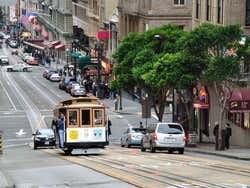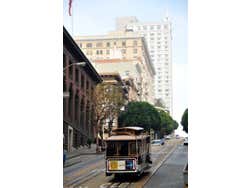
Cable Car
The Cable Car is not just a form of transportation but it is also a lot of fun in its own right.
This type of tram offers you the option of touring the city inside a section enclosed by glass or in its open section (at times, holding on to the side of the carriage).
A Species in Extinction
The first trams in San Francisco were pulled by horses that managed with difficulty to climb the city's steep hills. In the year 1873, the city's first electric tram was tested.
We could consider the tram as a survivor from a former age. This form of transportation was on the verge of disappearing in 1947 but a furious public strongly opposed its removal. In 1964 the cable car system was declared a National Heritage Site.
The reason for its near extinction was the high cost of its maintenance. A clear example of this is that every two or three months it's necessary to replace the cables that let the system run, costing some US$ 20,000 per cable.
To see how it works and learn more about this odd form of transportation, we recommend visiting the San Francisco Cable Car Museum.
Lines
The San Francisco Cable Car has three routes that cover some of the most interesting areas of San Francisco: the financial district, Nob Hill, Chinatown, Little Italy, North Beach, Russian Hill, and Fisherman's Wharf.
- Powell-Hyde: Leaves from Market and Powell, passes Union Square, Nob Hill, Russian Hill, and Lombard Street, ending at Ghirardelli Square.
- Powell-Mason: Leaves from Market and Powell and goes through Little Italy and North Beach before finishing its route near Fisherman's Wharf.
- California Street: Tours the financial district, Chinatown, and Nob Hill.
Fares
- Adults: US$ 8
- Over 65: US$ 4 (before 7 am and after 9 pm); other times US$ 8.
If you have a Go San Francisco Card, you can get a free day pass. Plus, you get unlimited trips with the Muni Pass or CityPASS.

